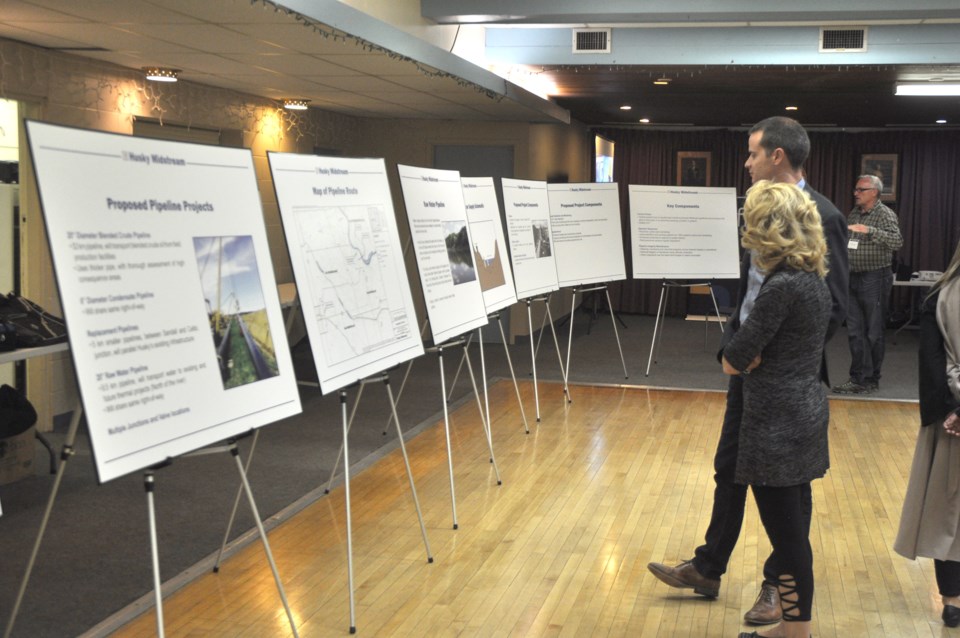North Battleford– Husky officials say they are applying all the lessons learned from the 2016 North Saskatchewan oil spill in designing new pipelines that will run from Lloydminster all the way up to the RM of Frenchman Butte.
Husky Midstream held an open house Thursday afternoon at the North Battleford Legion hall. It was a come-and-go event to provide details on plans for three pipelines along the route.
One would be a 20-inch pipeline which would transport the crude oil product back to the Lloydminster area from thermal sites in the northeast. The other is a eight-inch line to transport condensate to the thermal sites, which will blend with the heavy oil to be brought back.
The two lines would run for 52 kilometres from Lloydminster through the RMs of Britannia and Eldon and then to Sandall Junction and Celtic Junction in the RM of Frenchman Butte.
There are also plans for a 20-inch raw water supply pipeline. The route is considerably shorter, running from the Husky Direct Intake High Lift Station just to the south of the original pipeline crossing site, and run to Sandall Junction. The raw water, which is lifted from the North Saskatchewan River, will be used for production.
All three pipelines will cross the North Saskatchewan River; however there is a change in location from the pipeline that ruptured in 2016.
According to Husky spokesperson Travis Davies, “We’ve learned a lot from 2016.”
The main lesson they learned, he said, is to avoid slope. The new pipeline being proposed is located four kilometres downstream to the east of the original site where the spill happened.
Ground movement had been identified as causing the rupture in the line, resulting in 1,570 barrels of oil being spilled, a sizable portion ending up in the North Saskatchewan River.
Among the changes, said Davies, is the “concept of going hilltop to hilltop, to avoid slope altogether to avoid geo-active areas. You’ve got thicker pipe, better pipe. You’ve got a ton of technology in terms of analytics that can tell you what’s going on with the pipe in place, and improved procedures at our control room as well that set out timelines where if you hear an alarm, it gets dealt with in this way in this amount of time.
“Some alarms are immediate shutdown as well. So that’s an important aspect as well. Part of the point here is to get people to understand what we learned and how we are applying it to the new project.”
Also, the pipeline will be 80 metres below the river. The pipeline will cross at the same spot as the TransGas crossing, said Davies.
The three pipelines would end in the area where there is new production. They also hook up to pipelines that will take the product further north towards the Paradise Hill area. There is an existing junction at Sandall Junction that will take it in that direction.
This pipeline had been in the works even before the spill, say Husky officials, in order to support the growth of production in the area. There are four thermal projects in the construction phase and two more moving towards sanctioning. Husky is going through the process now of getting the regulatory approvals, with the holding of open houses being one of those requirements. Husky also held open houses earlier in the week in Melfort and in Prince Albert. They held open houses in Lloydminster and Maidstone last fall.
The hope from Husky is that they get through the regulatory approvals and start construction this fall. It would be a 10- to 12-month construction phase, “at which point we would put it into service,” said Davies. The capital cost of the project is estimated at $130 million.
The open houses saw considerable interest from people who want to know what the pipeline project is about, and what changes are being made.
“They want to know what’s different this time,” said Davies. They’re also interested in jobs, he said. About 300 to 500 jobs are expected to be created during the construction phase.




